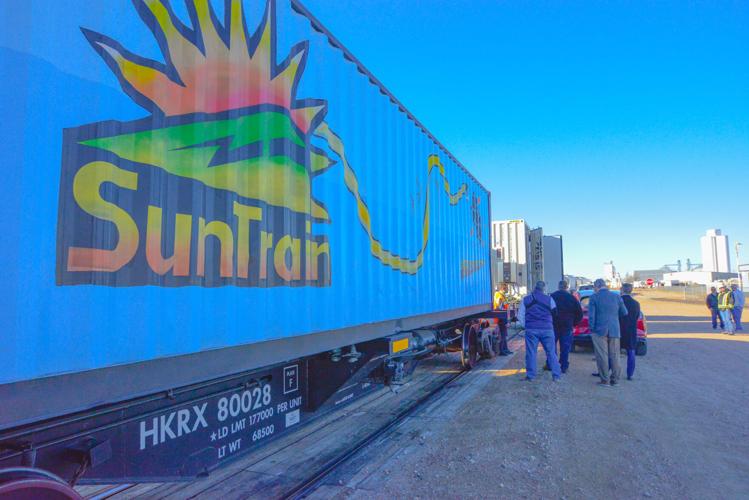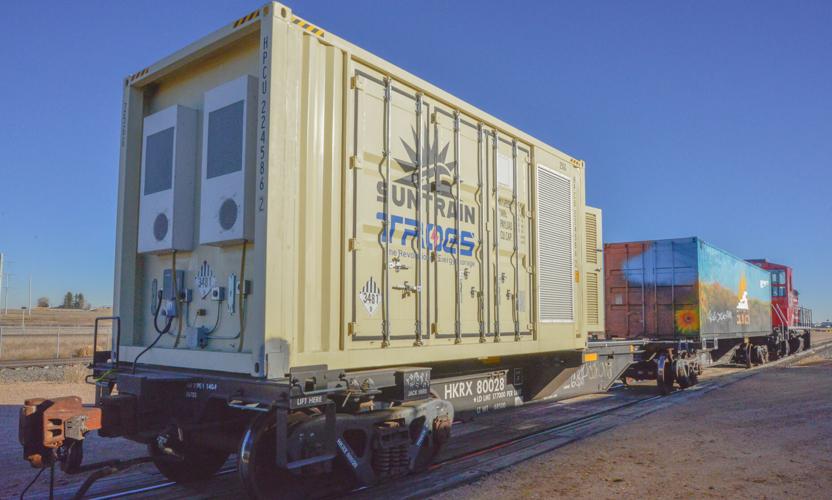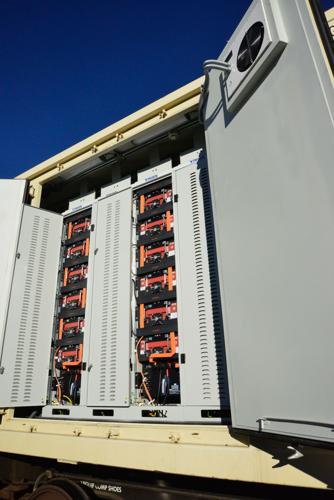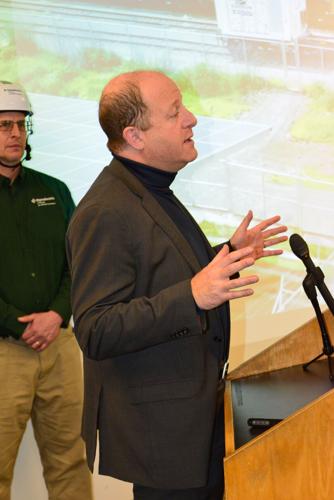Officials: Moving electricity by train can help reduce carbon pollution from power plants
Colorado Gov. Jared Polis and Xcel Energy Colorado CEO Robert Kenney announced a pilot project on Wednesday to move electricity much slower than the speed of light — at perhaps 60 mph.
By train, that is.
The Wireless Alternative by Train Transport (WATT) project is testing the viability of shipping up to two gigawatt-hours of renewable electricity stored in batteries anywhere in the country where rail lines exist but where electrical transmission lines don’t.
The pilot project will move about 384 megawatt-hours of energy daily by train from Pueblo’s Comanche Generating Station to Denver’s Cherokee Generating Station Trains, alternating recharging in Pueblo with discharging power on Denver’s already strained grid, said SunTrain founder and chief technical officer Christopher Smith.
“That’s enough to power 400,000 homes for an hour,” said Smith said. “And if we have a hundred of these rail cars, that’s when you start getting into the gigawatt-hour level, which is a tremendous amount of energy that can help support the grid.”
Smith said a two-gigawatt trainload of electricity could power two million homes for an hour or about 85,000 homes for a full day.
Smith said the design objective is to provide electricity from 4 p.m. to 10 p.m. when demand surges but renewable energy drops off.
The alternative now is to start up natural gas peaking plants, which detracts from Polis’ net zero carbon energy by 2040 climate change agenda. Having enough battery-stored electricity to avoid using natural gas during that peak period gets Colorado closer to achieving that goal, proponents said.
The theory behind moving all that energy by train rather than electrical transmission lines is that where transmission lines don’t exist, or are overloaded by burgeoning energy needs, a train-mounted rechargeable two-gigawatt battery can be moved from places where energy generation is plentiful to places that need a boost in available power, according to Smith. That’s especially especially true in the evening, when solar panels stop producing electricity.
This system, said Smith, has an advantage over building new high-voltage power lines — which can take 10 to 20 years to plan and build. In the short term, the railroad network can move substantial amounts of energy cost-effectively and can begin doing so as soon as the batteries and charging-discharging infrastructure are built, he said.
“One of the things that most people don’t know is that freight trains are actually incredibly efficient,” said Smith. “Those diesel locomotives get 454 miles per freight ton per gallon of diesel, which is incredible.”
Each battery car weighs 286,000 pounds. According to Smith’s numbers, a one-way trip from Pueblo to Denver would use about 3,780 gallons of diesel fuel, releasing about 84,672 pounds of carbon dioxide per trip. Assuming two trips per day along the 130 mile route, that amounts to about 30,903 tons of CO2 per year.
But Smith said the company plans to eventually move to all-electric locomotives, which can conveniently tap power from the massive battery bank it’s pulling, making the transfer 100% “carbon free.”
“We are 88% renewable, we are 88% green, 12% fossil fuel given that adjustability,” said Smith said. “So, if you think about in the sense that each train is delivering two-gigawatt hours of renewable energy, we’re using about 100 to 200-megawatt hours of diesel fuel equivalent actually to move that there. And we have very real plans to phase that out as we move towards further electrification and decarbonization with fully electric locomotives.”
One of the enormous challenges the nation faces in utilizing large amounts of widely distributed wind and solar energy is the cost of building the necessary transmission lines.
According to the 2021 Princeton Net Zero Net-Zero America report, the nation’s electric grid will have to triple in size by 2050 to meet the demand to service widely distributed renewable energy sources.
“Reaching the goal of net-zero greenhouse gas emissions by 2050 will require substantial investment in the U.S. transmission grid, to accommodate growing electricity demand from EVs, heat pumps, and hydrogen producers, and tap into the nation’s abundant renewable resource potential,” said Net- Zero America principal investigator Jesse Jenkins in a prior statement to The Denver Gazette. “One scenario included in the Princeton Net-Zero America study identified a need for about 60% more transmission capacity by 2030 and tripling current capacity by 2050.”
SunTrain’s website says it will cost $2.4 trillion at $2.3 million per mile to build out the national grid.
Xcel’s CEO pointed out that WATT is not a replacement for high-voltage power lines, such as Xcel’s $1.7 billion Power Pathway project in eastern Colorado.
“This is an additional solution that’s going to solve for multiple problems,” Kenney said. “This will not obviate the need for Power Pathway. Power Pathway is going to be a transmission line that’s going to be necessary to move electrons around. What this will do, though, is help with the congestion that could potentially be caused as we see additional load growth. So, this is going to be a supplement rather than something that will supplant power pathway.”
Smith said he agrees, adding he focuses on providing a system that can be up and running quickly to help supplement the growing power needs and the slow pace of building the needed transmission lines.
“I really want to underscore that this isn’t just a transmission solution,” said Smith. “This is a utility-scale energy storage solution that’s making use of the fact that most renewables are only available when the sun’s up. As soon as the sun goes down, we need renewable energy on the grid, and this can be both a base load solution to renewable energy being deployed 24/7 as well as the problems that are affecting our lacking transmission lines. Because we have to build 250,000 miles before 2050, and we’re building less than a thousand miles a year right now, using the underutilized railroad network, we can both store the energy at utility scale and move it around these congestion points while the grid has time to catch up and build additional transmission.”
“This is not going to necessarily displace the need for transmission lines,” said Xcel’s Kenney. “Let me make sure I say that. But what it will do is it’ll avoid curtailments, and it will allow us to use power at night because it’s going to charge down south. It’ll come up here and it’ll be able to discharge when renewables aren’t available. So, that’s probably from my perspective, one of the big benefits.”
“If this can pencil out as a cost-effective, reliable way to move power across our state, especially for time periods and in areas where it simply doesn’t make sense to have the large capital costs of transmission, infrastructure, construction,” Polis said.
The WATT project is seeking a $10 million grant from the U.S. Department of Energy’s Advanced Research Projects Agency to move them through the next phase of development.









